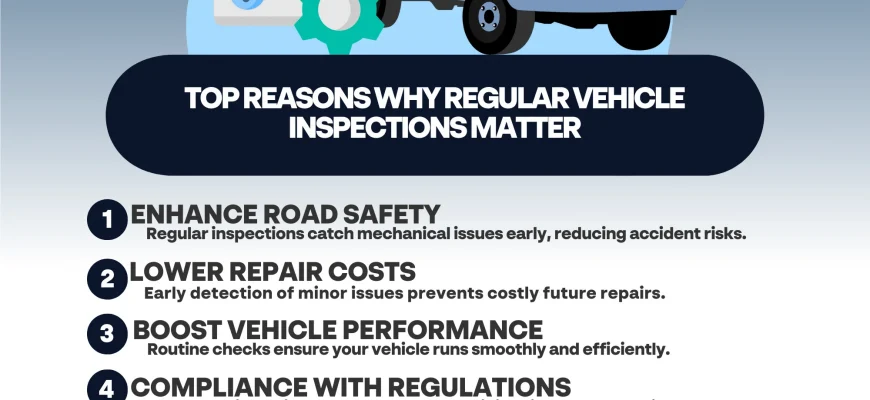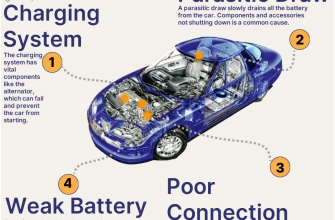When it comes to vehicle maintenance, one of the critical components that cannot be overlooked is the car inspection. This process, while often seen as a mere formality, plays a vital role in ensuring safety on the roads. However, many car owners find themselves perplexed about how long these inspections typically take and what factors influence this duration. In this article, we will delve into the intricacies of car inspections, exploring what they entail and the duration you can expect.
- What is a Car Inspection?
- How Long Does a Car Inspection Typically Take?
- 1. Type of Inspection
- 2. Condition of the Vehicle
- 3. Inspection Station Efficiency
- 4. Additional Services
- Tips for Reducing Inspection Time
- Preparing for Your Inspection: What to Expect
- Gather Necessary Documentation
- Perform a Pre-Inspection Check
- Post-Inspection: Understanding Results and Next Steps
- What If Your Vehicle Doesn’t Pass?
- Continuing the Journey: Post-Inspection Insights
- Understanding the Inspection Report
- Addressing Failures: A Step-by-Step Approach
- Preventive Measures: Keeping Your Vehicle in Top Shape
What is a Car Inspection?
A car inspection is a thorough examination of a vehicle’s components to ensure that it meets safety and legal standards. Depending on where you live, inspections may be required annually or biannually. They can cover a range of areas including:
- Brakes
- Steering and suspension
- Lights and signals
- Tires
- Exhaust system
- Windshield wipers and other essential components
How Long Does a Car Inspection Typically Take?
The duration of a car inspection can vary significantly based on several factors. On average, you can expect a standard inspection to take anywhere from 30 minutes to 2 hours. Here’s a breakdown of what influences this time frame:
1. Type of Inspection
Different types of inspections can lead to varying durations. A basic safety inspection is generally quicker than a comprehensive emissions test or a detailed pre-purchase inspection. For example:
- Basic Safety Inspection: Typically takes 30 minutes to 1 hour.
- Emissions Test: Usually lasts around 45 minutes.
- Pre-Purchase Inspection: Can take up to 2 hours or more, as it involves a thorough evaluation.
2. Condition of the Vehicle
The age and condition of your vehicle also play a significant role in how long the inspection will take. If your car is well-maintained and in good working order, the inspection may be quicker. Conversely, if the vehicle has multiple issues or requires repairs, the inspection process may take longer as technicians will need to investigate further.
3. Inspection Station Efficiency
The efficiency of the inspection station can greatly affect the length of time it takes to complete an inspection. Busy locations may have longer wait times, while well-organized stations may move through inspections more quickly. It’s advisable to choose a reputable inspection station known for its efficiency and thoroughness.
4. Additional Services
Some inspection stations offer additional services, such as oil changes or tire rotations, which can extend the total time spent at the shop. If you plan to combine your inspection with other maintenance tasks, be prepared for a longer wait.
Tips for Reducing Inspection Time
While some factors affecting inspection duration are beyond your control, there are steps you can take to minimize wait times:
- Schedule an Appointment: Many inspection stations allow you to book appointments, which can reduce waiting times.
- Choose Off-Peak Times: If possible, visit during off-peak hours to avoid long lines.
- Prepare Your Vehicle: Ensure your vehicle is in good condition before the inspection to avoid delays due to repairs.
Understanding the duration of car inspections is essential for every vehicle owner. While the average inspection can take between 30 minutes to 2 hours, the exact time will depend on various factors such as the type of inspection, the condition of your vehicle, the efficiency of the inspection station, and any additional services you may require. By being proactive and preparing your vehicle in advance, you can streamline the inspection process and ensure that your car remains safe and roadworthy.
Remember, a timely inspection not only keeps you compliant with local regulations but also enhances your safety on the road. So, the next time your vehicle is due for inspection, you’ll be well-prepared to navigate the process with ease!
Preparing for Your Inspection: What to Expect
As you gear up for your vehicle’s inspection, knowing what to expect can alleviate any anxiety you may have about the process. Here’s a quick guide to ensure you’re fully prepared:
Gather Necessary Documentation
Before heading to the inspection station, make sure to have your vehicle registration, proof of insurance, and any previous inspection reports at hand. This documentation not only helps to streamline the process but also ensures that you have all the necessary information readily available, facilitating a smooth interaction with the inspector.
Perform a Pre-Inspection Check
Taking the time to perform a basic check on your vehicle can save you from potential surprises during the official inspection. Here’s a quick checklist:
- Check Lights: Ensure all headlights, brake lights, and turn signals are functioning properly.
- Tires: Inspect tire pressure and tread depth to ensure they meet safety standards.
- Fluid Levels: Confirm that your oil, brake fluid, coolant, and windshield washer fluid are at appropriate levels.
- Brakes: Listen for any unusual sounds and check for responsiveness when braking.
By addressing these areas ahead of time, you can help ensure that your vehicle meets the required standards, potentially speeding up the inspection duration.
Post-Inspection: Understanding Results and Next Steps
Once your inspection is complete, you’ll receive a report detailing the findings. If your vehicle passes, you’ll typically receive a sticker or certificate indicating compliance. However, if there are issues, the report will outline necessary repairs and may include a timeline for re-inspection.
What If Your Vehicle Doesn’t Pass?
Receiving a failing inspection can be disheartening, but it’s essential to approach the situation with a clear plan. Here’s how to navigate this outcome:
- Review the Report: Carefully analyze the inspection report to understand the specific areas that require attention.
- Seek Professional Help: Consult with a trusted mechanic to get a detailed assessment of the necessary repairs.
- Make Repairs: Prioritize the repairs based on safety and compliance needs. Some issues may be critical, while others can wait.
- Schedule a Re-Inspection: Once repairs are completed, be sure to schedule a follow-up inspection within the specified timeframe to avoid potential fines or penalties.
Regular car inspections are an essential part of vehicle ownership. They not only ensure compliance with legal standards but also promote safety for you and other road users. By understanding the duration, preparation, and potential outcomes of inspections, you can take proactive steps to maintain your vehicle in top condition.
So, whether you’re a seasoned car owner or a new driver, embrace the inspection process as an opportunity to safeguard your investment and enhance your driving experience. After all, a well-maintained vehicle is a happy vehicle, and that translates to peace of mind on the road.
Continuing the Journey: Post-Inspection Insights
Once the inspection is completed, the next steps can shape your vehicle’s future on the road. The results of a car inspection can be a moment of relief or a call to action, and understanding how to navigate this phase is crucial for every car owner.
Understanding the Inspection Report
Your inspection report is like a medical chart for your vehicle. It details the condition of various components, highlighting which parts are functioning well and which need attention. Familiarize yourself with the key sections of the report:
- Pass/Fail Status: This section indicates whether your vehicle meets the necessary safety and emissions standards.
- Deficiencies: Any issues found during the inspection will be noted here, often categorized by severity. Understanding whether something is a minor fix or a critical safety concern is essential.
- Recommendations: Inspectors often provide advice on further maintenance or repairs, even if your vehicle passes. This can help you proactively address potential problems before they escalate.
Addressing Failures: A Step-by-Step Approach
If your vehicle does not pass inspection, don’t panic. Take a deep breath and follow these steps:
- Review the Findings: Go through the inspection report thoroughly to identify specific issues.
- Consult a Mechanic: Schedule an appointment with a trusted mechanic who can provide a detailed analysis and quote for necessary repairs.
- Prioritize Repairs: Focus on safety-critical components first, such as brakes or steering. Non-critical issues, while still important, can often wait.
- Keep Records: Maintain documentation of all repairs made. This can be beneficial for future inspections and can enhance your vehicle’s resale value.
- Re-Inspection: Once repairs are completed, schedule a follow-up inspection promptly to ensure compliance and avoid penalties.
Preventive Measures: Keeping Your Vehicle in Top Shape
To minimize the chances of failing future inspections, engage in regular vehicle maintenance. Here are some proactive strategies:
- Regular Maintenance: Stick to the manufacturer’s recommended maintenance schedule. This includes oil changes, filter replacements, and tire rotations.
- Self-Checks: Conduct routine checks on fluids, lights, and tire conditions. Catching small issues before they develop into larger problems can save you time and money.
- Stay Informed: Keep up with recalls and service bulletins that may affect your vehicle. Addressing these issues promptly can prevent inspection failures.
- Educate Yourself: Understanding your vehicle’s systems can empower you to make informed decisions about repairs and maintenance.
Car inspections might seem like a hassle, but they serve an essential purpose—keeping you safe on the road. By understanding the inspection process, knowing how to interpret results, and taking proactive steps to maintain your vehicle, you can ensure that your car remains in excellent condition. Whether you sail through inspections with flying colors or face a few bumps along the road, remember that the ultimate goal is safety and reliability.
So, next time your vehicle is due for an inspection, approach it as an opportunity for growth—both for your car and your knowledge as a responsible driver. A well-maintained vehicle is not just a form of transportation; it’s a testament to your commitment to safety and care. Embrace the journey, and happy driving!










This article cleared up so many questions I had about car inspections. The time estimates are particularly useful!
I found this article very enlightening. Knowing that a pre-purchase inspection can take up to 2 hours is crucial when buying a used car!
This article provides a comprehensive overview of car inspections. I appreciate the breakdown of timeframes for different types of inspections!
I never realized how much the condition of my vehicle could affect inspection times. This was very informative!
Great read! The details about what is checked during an inspection are super helpful for anyone looking to understand the process better.
Very informative piece! Understanding the different types of inspections and their durations really helps in planning ahead.
Fantastic insights! I always thought inspections were just a formality, but now I see their importance in ensuring road safety.